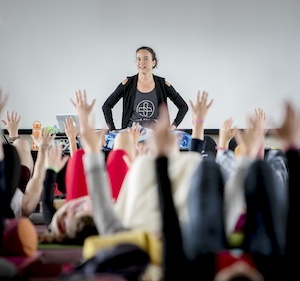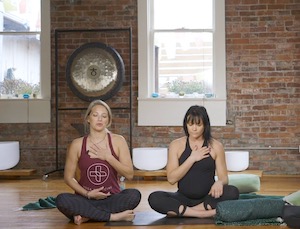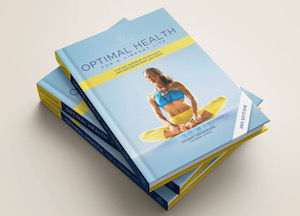Articles, In the Press, Resources, Yin, Restorative and Meditation
Mindfulness Meditation in Silicon Valley
By Michelle Pendleton for Yoga Medicine®.

When I started teaching at a prominent Silicon Valley corporation in 2017, I immediately noticed the intensity and achievement-oriented energy of many of the class participants. These students told me that they sought out yoga for life balance and centering, but I noted they were primarily offered (and also gravitated to) fast-paced vinyasa and power yoga sessions which reinforced an emphasis on speed, pushing oneself to the limit, and focusing on an end goal instead of the process. According to Boston Consulting Company, mindfulness boosts the potential for corporate agility initiatives and seamless transformations.1 It helps people to inspect and adapt their behaviors in short cycles, relax so that they can rewire established attitudes and think clearly in the midst of overwhelming digital stimuli. As yoga and meditation teachers, we are aware of the stress reduction and cognitive benefits of these practices, but how do these practices translate to a corporate environment?
The Questions Are:
- How can we as teachers integrate mindfulness in a corporate environment that is often structurally resistant to slowing down in order to emphasize the present over the future and the value of the process over quantifiable results?
- How can we retain the sacredness and tradition of the practice to minimize co-optation by such corporate imperatives and thereby maximize the benefits for our students seeking pain and stress reduction, tranquility and equanimity, and the building of community instead of isolation?
After repeatedly seeing that teaching asana alone often didn’t appear to enable students’ awareness of their achieving mindset and clinging mind, I was determined to integrate meditation into my corporate yoga classes.The Vinyasa workouts, for a significant portion of my clients, seemed to be more of what they experienced in their typical workday: rapid, goal-driven activity that perhaps exacerbated existing physical challenges such as wrist, neck, and back pain. Of course not every student approaches the practice this way, but it certainly was the undercurrent.
More and more students approached me with questions about nagging pained sleeplessness, and it was clear to me that more meditation and pranayama to help balance the nervous system would fill an apparent need, but providing a strong vinyasa flow was still expected.
There are clearly beginnings of a mindfulness infrastructure here in the Silicon Valley, the hub of technology and innovation. A September 2018 article in the Nation cites how many hours Americans now spend at work – a third of Americans work over 45 hours per week and nearly 10 million work over 60, nearly a 8% increase in time at work since 1979.2 These numbers are conservative for tech environments so incorporating mindfulness and meditation on the job seems not only appropriate but necessary.
Mindfulness has been appropriated by corporations as another productivity tool, but it also undeniably benefits the mental, emotional, and physical health of the individual practitioner as well as their work production. Thus, it behooves us to take advantage of the corporate receptivity to mindfulness programs in the current moment. Sara Lazar, a Neuroscientist at Harvard University, speaks to the benefits of meditation: “Results suggest that meditation can produce experience-based structural alterations in the brain. We also found evidence that meditation may slow down the age related atrophy of certain areas of the brain, helping you react less to stress and feel calmer and in more control.”3
Here are five suggestions for ways to incorporate more meditation and equanimity into your corporate-based classes:
1. Infuse research-based science in your classes and connect it to your class theme.
An example that I might reference is how the pre-frontal cortex has connections to other parts of the brain that help us cultivate positive emotion. This reference is from a recent Health and Wellness Company podcast where Richie Davidson explained, “ If we worry about the future and ruminate about the past – those are the kinds of things that can ensnare us and cause ulcers but we can also harness this potential to direct our minds on positive qualities and nurture human flourishing.”4
2. Short meditation as the students arrive to get them grounded and/or close with a meditation.
I often have students close their eyes and begin by observing their body and their whole body breathing. I encourage the awareness of what begins to arise, whether it’s images, incessant thoughts, sounds, or an uncomfortable emotion. Then come back to the focal point of the breath. Spend approximately 2-5 minutes, depending on the level of the class.
3. Create a sequence that weaves mindfulness into the movement together.
In this example, the focus of the asana could be any particular joint, balance, or breath while the cueing intermittently to weave your mindfulness touch-points as referenced below. The key is cueing reminders such as the nature of the mind to go back to the default network or how we can notice without judgment. Then return again and again to the ebb and flow of the breath.
4. Incorporate short mindfulness points during the sequence, especially when in a relaxing hip stretch, child’s pose, or a chest opener.
Refer back to the highlighted research on how the prefrontal cortex connects to other parts of the brain which helps us to access and sustain positive emotions.
5. Post Savasana
Close with a final point of how just even a few minutes of mindful breathing every day can help develop a habit that will shed positive light on ourselves and those with whom we come into contact.
The Results of Incorporating Mindfulness into my Corporate Classes
In my experience, after six months students commented that they enjoyed class because they felt “different.” They felt more connected to their bodies and in tune with their breath on and off the mat. Deploying language to help the students deepen their interoceptive awareness had an impact. One young programmer described how he struggled with chronic insomnia and back issues but after taking my classes he sleeps well, he notices what’s happening in his body and mind, and consequently doesn’t suffer from the same degree of nagging lower back pain from all his late nights on the computer. Although students were not coming to the class specifically to meditate, they benefitted from the mindfulness practices that I integrated into the existing yoga class structure. Furthermore, many signaled curiosity in additional mindfulness and meditation by signing up for my newsletter, emailing me about the classes, happily providing me with testimonials, and attending the occasional community meditation events.
My goal in integrating meditation into the corporate yoga classes was to create something meaningful for this specific Silicon Valley audience and I believe that this approach applies to any other community in which clients want to develop a practice to deal with stress, improve their relationships, or discover more self-compassion.
After feeling some success, I have approach the Fitness and Wellness Director about adding meditation classes to all the fitness center locations and she agreed to incorporate this into the 2020 schedule! My next experiment will be to build a community of meditators with the high-tech clientele outside of Corporate Fitness Centers in the Valley, which will be the next part of this series of articles.
References:
- Greiser, C. and Martini, J. “Unleashing the Power of Mindfulness in Corporations.” Boston Consulting Company, April 26, 2018. https://www.bcg.com/en-us/publications/2018/unleashing-power-of-mindfulness-in-corporations.aspx
- Covert, B. “Americans Work Too Much Already: The Save American Worker Act would do nothing of the sort, but it would force many employees to log more hours,” The Nation, September 28, 2018. https://www.thenation.com/article/archive/americans-work-too-much-already/.
- Lazar, S. “Mindfulness and the Brain: What Does Research and Neuroscience Say?” Positive Psychology, September 7, 2019. https://positivepsychology.com/mindfulness-brain-research-neuroscience/
- Davidson, R. “The New Science Behind Mindfulness – Center For Healthy Minds,” BB&R Podcast, Episode 32, June 19, 2019. https://www.bbrconsulting.us/podcast/2019/richie-davidson












